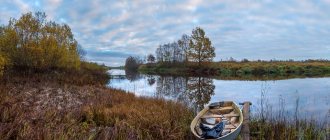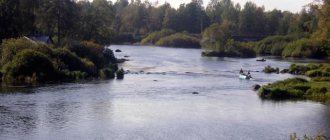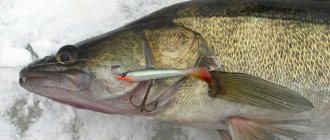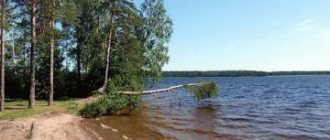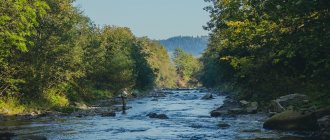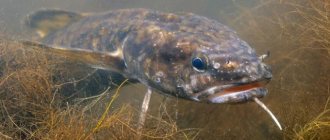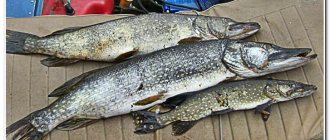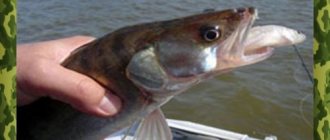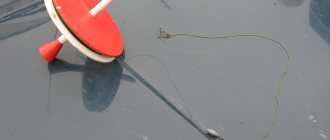We, residents of St. Petersburg and the region, are incredibly lucky with our place of residence. We have a huge number of reservoirs rich in fish within our reach.
For example, we want to catch pike perch. Where to look for it? Where can you catch pike perch in the Leningrad region? On Lake Ladoga? On the Gulf of Finland? On the rivers and lakes of the Leningrad region? Or maybe in Neva, in the city center?
The correct answer to this question is that you can catch pike perch almost everywhere in the region!
Pike perch lives in almost all reservoirs of the Leningrad region, both large and small. It is found in the most seemingly unexpected places, for example in the Neva, in the center of St. Petersburg.
Pike perch on the Neva. VKontakte user photo
Let's take a look at the promising places for pike perch fishing in order. Let's start with the Neva, within the city. It’s a controversial place to eat caught pike perch, but for the sake of sport, you can try to look for this predator on the embankments of St. Petersburg.
Fishing for pike perch on the Neva
Pike perch in the Neva is found almost everywhere, and catching a pike perch weighing 1-2 kg is not something outstanding. There are specimens weighing up to 5 kg:
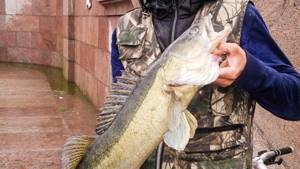
Pike perch weighing 5 kg on the Neva. VKontakte user photo
Where to catch pike perch on the Neva?
They catch pike perch from the shore on all embankments of the city, in the Central Park of Culture and Culture
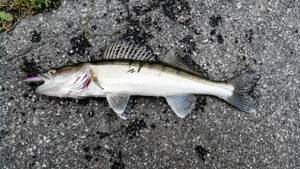
Sudak on Petrogradskaya embankment. Photo of a user of the VKontakte website.
and on the islands
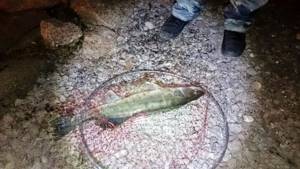
Pike perch on Kanonersky Island. Photo of a user of the VKontakte website.
If you have a boat, then there is no need to go far from the city; you can catch pike perch in the Gulf of Finland, right within the city.
For example, good pike perch can be caught in the area of the park of the 300th anniversary of St. Petersburg
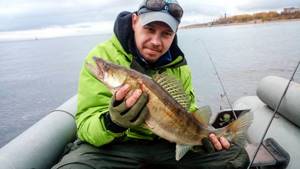
Pike perch 2 kg in the Gulf of Finland. Photo of a VKontakte user
What time to catch pike perch?
They catch pike perch both in winter and summer. In winter, this fish is well caught during the period of first ice, and then at the end of cold weather, at the beginning of spring.
A good meal is in the spring before spawning. The optimal fishing time is mid-May and August, but much depends on the characteristics of a particular reservoir. It is also necessary to take into account fishing permits - for example, in the Gulf of Finland, fishing for pike perch is officially allowed only from June 15, which is associated with ensuring safe spawning of fish.
In late autumn, you need to look for pike perch in pools, holes, channel edges - in general, at depth. Pike perch prefers the dark, but can be caught both day and night. Smaller pike perch should be caught at dawn, large ones - in the dark, when they lie in wait for their victims.
The time of day at which this fish is especially well caught depends on the time of year. It is better to go fishing for pike perch at night from the end of summer.
Fishing for pike perch in the Gulf of Finland
Pike perch are caught everywhere in the Gulf of Finland. If you have the desire and opportunity to get out to less crowded areas, you can look for it both along the southern (to Ust-Luga) and northern (to the border with Finland) coast of the Gulf of Finland. Pike-perch is found everywhere.
Where to catch pike perch in the Gulf of Finland?
It is caught on average at a short distance from the shore, from one to five kilometers, which is much closer than, for example, on Lake Ladoga.
In the Gulf of Finland, pike perch are caught from boats, on the track (trolling) or by casting. On average, pike perch from the Gulf of Finland is smaller than its Ladoga counterpart, so if you need trophies, then you need to go to Lake Ladoga for pike perch.
Sudak on Ladoga
Probably the most famous fishing spot on Lake Ladoga is Novaya Ladoga, at the mouth of the Volkhov . I think that almost all the fishermen in our region have fished here at least once, and they’ve heard and read absolutely everything about this place. All my most successful fishing trips for pike perch took place here. Over the past three or four years, I have not had a single fishing trip where I caught less than 20 kg, and in fact, most often much more.
The success of fishing in a given place, as in any other place, is influenced by several factors, the most important of which are the weather and knowledge of where the fish are currently located. It's no secret that the weather greatly affects the fish bite. I always choose a warm and windless day and don’t stick to weekends, but choose the travel time based on the weather. Since fishing takes place in the evening and at night, and the fishing place is relatively close to the city, this can be done even without interrupting work. Here, at this time, pike perch gather in huge flocks that hunt no less huge schools of smelt, which are also located in these places. The area where these flocks can be located reaches several kilometers. Therefore, it is enough just to find where it is, and the rest, as they say, is a matter of technology. The easiest way to determine the fishing location is by looking at the boats that are already fishing, and accordingly, where there are more of them, you need to start fishing. This, of course, is more reminiscent of winter perch fishing, but it works quite well. I advise you, however, not to get into the crowd itself, since fish can be found nearby, but your nerves will remain in order, since the number of boats sometimes goes off scale. On one of my last fishing trips, I tried to count the number of boats that were in sight, and I was off by 300. Fish usually stands in the upper layers of 1.5-2 m, although fishing itself takes place at depths of 10 meters, and less often shallower. Distances from shore can also be significant. I had to fish at a distance of 20 km from the coast, so the motor should be powerful enough, at least to avoid spending a lot of time to reach the fishing spot. Of course, pike perch is also caught on coastal dumps, but there it is not so concentrated and is found mostly mixed with other fish, mainly perch and pike. The size of the fish here is relatively decent, averaging 700-800 grams. There are periods when larger specimens are found, but not very often. You can fish here with spinning rods and casting, and quite effectively. It is necessary to use wobblers with a depth of 1.5-2 meters. But few catch it this way. At the mouth of the Volkhov there is good fishing with jigs, but the size of the pike perch here is also not very large, but the bite can be very active. But, in my opinion, it’s not very interesting to catch small fish with virtually no chance of catching something more significant.
Recently, quite a lot of pike perch have begun to be caught on Lake Onega . There, pike perch begins to be caught from the beginning of July. The size of the fish is much larger than on Lake Ladoga, and on average reaches 1.5 kg, which is very good at the moment. True, I haven’t come across particularly large specimens yet, the maximum is about 4 kg, but there are practically no small items. You can catch pike perch in the same places where salmon are caught. If 5-6 years ago, pike perch on Lake Onega was rather exotic and was found extremely rarely, now its number has increased many times, and in the summer it makes up the bulk of the catch. Since the average weight of the fish is quite large, the total catches reach quite decent sizes, some manage to catch up to 100 kg. As a matter of principle, I fish only the amount that I can eat, and therefore, in terms of catching pike perch, this reservoir is not very interesting for me personally; in the heat, it is simply impossible to bring fish from there to St. Petersburg - it will spoil.
Naturally, pike perch is caught not only in the places that I described, it is also caught in large lakes, as well as rivers, including pike perch in the Neva, and quite well, but there are not so many places where you can catch it en masse , and perhaps I described all of them. Of course, this applies to the North-West region.
Fishing for pike perch in the south of Lake Ladoga
Pike perch in Ladoga is caught in the summer, almost along the entire southern coast, but at a fairly large distance from it: from 10 to 20 kilometers. In fishing areas, depths reach 15 meters, but pike perch bite mainly closer to the surface.
Where to catch pike perch in Lake Ladoga?
Pike perch fishing is popular along the entire southern coast of Lake Ladoga, in the area of such settlements as: Lednevo, Kokorevo, Kirikovo, Kobona, Nazia, Ligovo, Chernoe, Dubno, Novaya Ladoga, Krenitsy, Koshkino, etc. Sometimes there are quite large specimens:
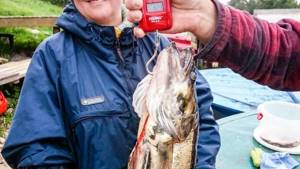
Pike perch weighing 3.3 kg, caught in the Ligovo area. Photo of VKontakte user.
Sudak in the Kirikovo region:
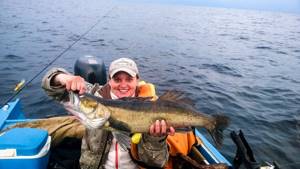
Pike perch caught in the Kirikovo area. Photo of VKontakte user.
Zander
- 623
- Victor Sabunaev Sport fishing
TABLE OF CONTENTS
Pike perch is common in the basins of the Black, Azov, Caspian, Baltic and Aral seas. Inhabits Ladoga, Onega, Chudskoye, Ilmen and many other oxygen-rich lakes. Acclimatized in a number of freshwater lakes and seas. Reaches a weight of 8-10 kg;
occasionally specimens weighing up to 20
kg are encountered.
Pike perch has two biological forms: semi-anadromous and residential. Semi-passing pike perch goes up the river in the south in March - April. It spawns in April - early May at water temperatures up to 20-25°. Having spawned, it immediately rolls into the sea or pre-estuarine space. In the north, the spring movement of semi-anadromous pike perch is observed in May - June.
In summer, pike perch almost always choose places with a sharp difference in depth for their stops. Usually these are cluttered pools or holes, adjacent to sandy or rocky shallows. He also likes to stand near bridge abutments and near ice cutters. Often found under rapids and dams, where rip currents form. In reservoirs it usually adheres to the slopes of the flooded river bed. In large bodies of water, it sometimes makes migrations associated with the movement of schools of small fish and local changes in the oxygen content in the water. Avoids areas overgrown with aquatic plants; The bottom prefers sandy or gristly. They live in small schools; large pike perch live alone.
At the end of August - September, pike perch leaves their summer camps and goes to winter in the deepest parts of the river or lake. During the autumn movement and wintering grounds it sometimes forms significant accumulations.
Spawning occurs at the end of May - June, and sometimes at the beginning of July at a water temperature of 13–14°. After spawning, the fish partially linger near the spawning grounds for a long time. Residential pike perch does not make noticeable spawning movements and spawns at approximately the same time as semi-anadromous pike perch. Eggs are often spawned in shallow, well-warmed areas: in hollows, in reed thickets, on sandbanks and rocky ridges. Less often it spawns at depths (in Lake Ladoga). Spawns at dawn and at night.
Pike perch feeds mainly on small fish. In some reservoirs, additional food for it consists of shrimp, various shellfish, and worms. Feeds throughout the year; most intensively - in the post-spawning period and during autumn migrations, least active - in the spawning and pre-spawning periods.
Basically, pike perch gets food and stays near the bottom, but sometimes, in pursuit of prey, it comes to the surface of the water and splashes. Its game is reminiscent of the game of a perch, but without the characteristic slurping sound of the latter.
Walleye are a typical predator and are caught either with live bait or with artificial bait that imitates a live fish. Occasionally, a dead fish, a piece of fish or an earthworm is used as bait.
Live bait is chosen in accordance with the usual food of pike perch in a given body of water. In northern lakes these are vendace, bleak, and ruff; in the lakes of the middle zone - bleak, verkhovka, roach; in rivers - gudgeon, bleak, dace; in the seas - goby, anchovy, sprat.
Regardless of the method of catching live bait, it is best to attach it to a tackle consisting of two single hooks. Hooks must match the size of the live bait; Usually hooks No. 9-12 are used.
The methods of catching pike perch with live bait are quite varied.
In lake-type reservoirs, circles are widespread. Catching pike perch with them is more difficult than pike. Pike perch are almost never distributed evenly throughout the reservoir, so for successful fishing you need to know exactly where they stop. To do this, if the reservoir has not been studied, the mugs are allowed on their first swims at large intervals. Having discovered the area where the pike perch is located from the first turns, carefully measure the depth in this area. Subsequently, the circles are brought closer together, but they try to launch them so that they float along the border of deep and shallow places or along a deep furrow stretching among the shallows. If this cannot be achieved with a given wind direction, then it is better to install the circles in the right place on the anchor. It is very important to correctly adjust the depth of release of the live bait - it should be most of the sink as close to the bottom as possible, but not touch it. Pike perch bites at half-water or closer to the surface are extremely rare.
In deep holes in lakes and in deep and quiet river pools, pike perch are sometimes caught vertically. The rod used is short - no more than 1.ad long. A coil is desirable. The sinker is spindle-shaped and of such weight that the live bait cannot lift it high from the bottom. Fishing is done either from a boat installed on one bow anchor (or pereton), or from bridges, rafts, etc. You can also fish from a slowly moving boat, controlling it with one stern oar. The live bait should not reach the bottom a little; at times it is raised and lowered again.
In rivers with a current, if the bottom is flat over a long distance, good results are obtained by fishing for pike perch in a retrieve with a long release of the float. If the bottom in the selected area has ledges or is cluttered with large stones, it is more convenient to fish with a running bottom. When fishing in rivers from the shore, you can use an ordinary bottom fishing rod.
The pike perch's bite on live bait is reminiscent of the pike's bite: having grabbed the prey and tightly squeezing it with its teeth, it usually moves a few meters to the side and, turning the bait over, begins to swallow it. If the pike perch takes greedily, you need to take your time with hooking and let him take the bait properly. If the pike perch takes it sluggishly, then when fishing with a two-hook rig, you must hook it at the first pull, otherwise it may leave the bait. You need to hook vigorously, taking into account that the pike perch, having grabbed the prey, tightly clenches its jaws.
The sheer trolling of pike perch is fascinating. This method is used to catch fish from boats, bridges, rafts, etc.
The rod is used more rigidly than for trolling perch. This is important for good hooking. A coil is desirable. It allows you to quickly change the depth of the spinner, which is often necessary in the summer. The scaffolding should be inconspicuous; Usually a vein with a diameter of 0.3–0.4 mm is used.
White spinner (silver or tinned) 70–80
mm
. It is better if it is equipped not with a single hook, but with a small tee. Instead of a spinner, a dead fish on a tackle can be used. During a sluggish bite, a piece of fish should be placed on the tee of the spinner; In summer, replanting is almost mandatory, since pike perch rarely takes a naked spinner well at this time.
The glittering technique is common. The line is released so that the spinner is 10–15 cm
did not reach the bottom, then smoothly raise it by 20–30
cm,
quickly lower it to the previous depth and pause for 3–5 seconds.
Until recently, in some places it was practiced to catch pike perch using a mirror pellet. With the advent of the heavy jig, most anglers began to use it. Pike-perch takes a jig more readily than a pulk, and in addition, when fishing with the latter, there are many occurrences.
Pike perch, like other predatory fish, is caught with a spinning rod and on the track. The gear - rod, reel and line - is used the same as for catching pike.
The bait is selected taking into account the characteristics of the reservoir. In most rivers and lakes, pike perch are more willing to take sluggishly playing spinners with separately visible vibrations and revolutions. The easiest way to achieve this kind of game is to use lures of the “norich”, “geneva”, “kola”, “pig”, “baikal” types. The thickness of the spinners can vary from 0.8 to 2 mm
(depending on the speed and direction of the current in relation to the wiring and the depth of the bait).
The usual length of spinners used ranges from 60 to 80 mm,
but in some reservoirs of predominantly lake type (for example, in the Gulf of Finland, Rybinsk Reservoir), pike perch is better caught with spinners 120–130
mm long.
Lures should be silver or tinned and only in good lighting - brass. Almost everywhere, a dead fish on a tackle is good, which must be used either without blades at all, or with very small ones, putting a small narrow fish on it.
The speed of moving the bait is essential. Pike perch rarely rushes after fast-moving bait and is more willing to grab one moving slowly or at medium speed. Therefore, special attention should be paid to selecting the weight of the sinker; By changing it, you can vary the speed of the bait at your discretion.
The choice of fishing method with artificial bait depends on the nature of the reservoir. In shallow reservoirs of the flat type, which have the same depth over a long distance, it is best to fish with an ordinary path. If the reservoir is large and deep and also has an uneven bottom, then it is more convenient to use a deep-water path. Small pools, individual pools and riffles are good to fish with a spinning rod.
With any fishing method, the bait must be kept near the bottom, since bites in mid-water or on top are very rare.
The pike perch bite when fishing with a spinning rod and on the track is very similar to a hook: no shocks are heard, and only after a while the pike perch begins to shake its head, like a perch. Fishing for pike perch is not difficult; It is only difficult to lift him from the bottom, and then he walks calmly and soon gets tired.
The best time to catch pike perch is in the evening, from sunset until complete darkness, and in the morning, from the first glimmer of dawn until sunrise. In some reservoirs, pike perch can be caught in the middle of the day.
TABLE OF CONTENTS
Share link:
- Click to share on Twitter (Opens in new window)
- Click here to share content on Facebook. (Opens in a new window)
- Click to print (Opens in new window)
- Click to share on LinkedIn (Opens in new window)
- Click to share on Telegram (Opens in new window)
- Click to share on WhatsApp (Opens in new window)
- Click to share on Skype (Opens in new window)
- Send this to a friend (Opens in new window)
Fishing for pike perch in the north of Lake Ladoga
In the north of Lake Ladoga lie the famous Ladoga skerries. The natural grandeur of these places compensates for the poorer fish mass compared to southern Ladoga. Pike perch in the Ladoga skerries is quite rare, much less common than on the southern coast of Ladoga, but the pleasure of fishing in the skerries is unforgettable.
Where to catch pike perch in the Ladoga skerries?
In the north of Lake Ladoga, pike perch is caught in the area of such settlements as: Kuznechnoye, Berezovo, Kurkieki, Lumivaara, Mikli, Kortela, Sortavala, etc.
Neva pike perch in spring
In April, you can catch large pike perch on the Neva, the main thing is not to miss this moment.
For several years in a row, around the same time, street fishers find themselves on a week-long feast of large pike perch, which is actively caught with jigs at depths of 5-6 meters.
This year everything is repeating itself. The weather is great, the sun gives hope for comfortable fishing... There is information that the first monster was caught weighing as much as 7 kg!!! What's not a reason to uncover your brand new horse riding spinning rod Shimano SpeedMaster CX 270H? I have already tried this stick in Moscow, but, unfortunately, without fish.
The spinning rod has excellent throwing characteristics and is very reliable, because The rod blank is made using HPC technology.
High Pressure Carbon technology - sintering carbon fiber under high pressure to evenly distribute the resin in the blank, this gives a 40% advantage in reliability over classical technology and, of course, the addition of Biofibre organic fibers to the resin, which further increases the power of carbon by 4 times !
That is why my choice fell on the SpeedMaster CX.
If there is a chance of catching a trophy from a high embankment, then it is better not to leave any chance for error.
I'm here. Today the pressure dropped and it started snowing. A strong side wind burns your face with snow... Well, as usual!!! I'm always lucky with the weather! Yesterday there was sun, today there is a piercing wind with snow...
Today I decide to use a cord with a diameter of 0.14 mm instead of 0.10 as in Moscow. Still, there are more holds in St. Petersburg!
There are not many fishermen on the embankment... One spinner said that in the morning he had several good, but unsuccessful strikes of pike perch on the green run-through rubber.
Let's go!
The first to go into battle will be the SoRun Joker Shad 4″ vibrating tail with a load of 28g on VMC offset, pike took it quite well in its time...
I'm investing in casting.
Wow, that went great! Despite the wind, the bait flew to the working distance!
Of course, the speedmaster throws excellently.
I'm doing the wiring, the wind blew out the loop. It’s difficult to control the movements of the bait, but the stick is quite responsive, so I feel the weight touching the bottom...
Two turns, pause for a second or two... Knock, two turns again, pause...
And then the bait freezes... Hook!!!
But no, dead hook!!!
I try to shake off the bait, taking the cord in my hand... Nothing works. Apparently there is reinforcement or stone at the bottom.
In frustrated feelings, I pull the cord. But then, with an awkward movement, I strike the cord against the granite parapet. No!!! I just lost 40-45 meters of cord... After all, the cord is a consumable.
Fortunately, I have a bag of the new Sufix Matrix pro 0.12 mm with me, which I took as a spare.
I move away from the ill-fated point a few meters upstream.
Casting Almost the entire cord flies out, there is critically little of it left. If the fish takes it on the throw, then the cord will not be enough to release the line.
But I’m too lazy to rewind, so I leave it hoping for the best.
After fishing for a while, I didn’t get any bites. I decided to walk along the embankment and find out how the others were doing. Approaching one couple, I learned that they had just caught a small pike perch on the outlet with a white twister. The rest have nothing.
I change baits. I resist... Zero...
My partner placed a white twister on the outlet in the hope of repeating the results of successful spinners.
About 15 minutes pass, he calls: “Vital, sit down along the way!!!”
I run up and the pike perch actually bends the powerful spinning rod. The diversion worked. The pike perch pulled 1.8 kg.
- Vitalya, put a divert! See, he takes it!
- No, I want to catch him in a jig, especially since my hands are already so frozen from the cold that I can’t bandage them anymore...
I’m happy for my friend, his pike perch warms me up with a good mood. But this is not enough. I'm going to get into the car to warm up.
The weather is just right for fish, cold, windy, snowy...
Having warmed up, I go to the embankment.
Having looked around a decent area, I found a hole with a pronounced rise. In this area, the bait did not fall, but dragged along the sandy bottom with difficulty.
Interesting place! And you don't have to throw it very far.
I'm making a cast. The bait is carried into this hole. I feel it knocking on the bottom, knock, knock.
And suddenly the bait did not make another “knock”, just before leaving the hole!
A hook from the “just in case” series.
Whoops!!! Come on!!! The spinning rod bends...
In a split second, do you understand whether it’s a fish or a hook?!?
And then I understand that something has gone wrong at the other end of the line.
It can be anything: a boot, a basket of five or a banal package...
After dragging about 5-6 meters, he fluttered and began to resist... Oh yes, baby!!! Dad will be happy!
The pike perch on the shore undergoes a photo shoot and is released home.
Now you can leave...
The handsome man pulled 2.05 kg.
I used edible Storm So-Run Makan Minnow 4″ rubber in a natural color with bleach.
An excellent start to the pike perch season.
“Hopefully he’ll be the smallest this year!” — I thought jokingly and went home.
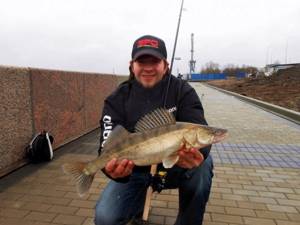
Fishing for pike perch on the Karelian Isthmus
Pike perch is present in many large reservoirs of the Karelian Isthmus
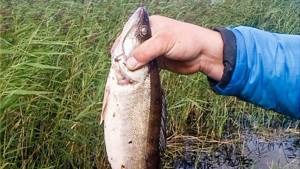
Pike perch on Lake Sukhodolskoye. VKontakte user photo
For example, pike perch fishing is common in reservoirs included in the Vuoksa system:
Pike perch caught in the Sinevo area on Vuoksa. Photo of the group “Sinevo” on the VKontakte website.
In particular, in the Baryshevo area:
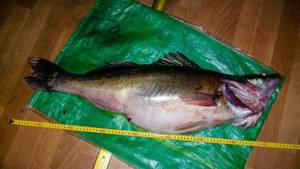
Pike perch caught in the Baryshevo area on Vuoksa. Photo of a user of the VKontakte website.
In addition, pike perch is found in such lakes of the Karelian Isthmus as:
- Lake Pravdinskoye
- Lake Komsomolskoe (rare)
- Lake Sukhodolskoe
- Lake Otradnoe
- Trostnikovoe Lake
- Lake Glubokoe
- and others
Results of fishing on the Neva
The pike perch caught on a jig was worse. We caught two pike perch on a retractable leash (in 2 hours), one of them under a kilogram.
Pike perch very often comes out for a short period of time. You still need to figure out the time to get here and have time to catch a certain amount of fish.
We also tried to drive the okushka. We caught several small perches.
We used Akara baits, such as the Akara worm. Today these two colors worked for pike perch.
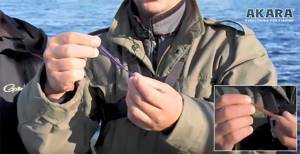
Two bait colors that worked for pike perch today
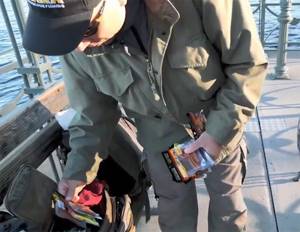
Among the gear used: Akara Eatable Spike twisters (colors X040 and L7), Spike (colors 11 and 413), Super Twister 30, Fat Twister 25, Akara Feeder Braid X-4 Dark Gray, Ultra Cast X-8 Multicolor, Akara fluorocarbon FX 100%.
We finished our fishing at midday. A typical day for street fishers in St. Petersburg.
Jig on the Neva
The greatness of a body of water always determines the power of the gear and the size of the bait needed for fishing in it - a truth that does not require proof. In addition to this, certain knowledge is also needed to persuade a body of water to share its wealth. In this case, it is the Neva within the boundaries of St. Petersburg.

Tackle and cargo weight...
The main two features of the Neva are its very powerful current and decent depths almost immediately under your feet. Judging by the location map, in convenient and most popular places with fishermen, the depth ranges from 3 to 10-12 meters. Accordingly, you don’t have to think for long that weights for baits need at least 20 grams. Otherwise, the bait floating in the water is carried away too quickly, in some places even washing it to the shore without giving the fisherman the opportunity to feel the sound of the weight on the bottom.
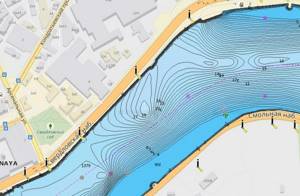
For fishing on the Neva, spinning rods with typical tests in the range from 10 grams to 40-50 grams are most optimal. The action of the rods is, of course, fast or extra-fast – a classic jig. And obviously we don’t need short spinning rods, preferably from 2.7 meters, because... in many places, judging by the same location map, there are a lot of tempting holes and most of them are located at a distance of 50-70 meters - you will have to leave with all your heart. By the way, the holes on the Neva can be “read” very well by experienced fishermen even without this map due to the fact that the bottom in the Neva is quite hard.
Equipment and wiring...
On the Neva, only two jig rigs are traditional: an articulated one on a Cheburashka or a jig head and a retractable leash. I noticed the drop shot less often, although sometimes I use it myself, and I have never seen all kinds of “Carolinas” and “Texas” from anyone, which does not exclude their use in principle. But it is obvious that the people’s experience here is not an empty place - in the use of a narrow designated set of equipment on the Neva, a clear logic is clearly visible, due to far from the easiest conditions.
Wiring on the Neva is not particularly tricky. Because of the aforementioned powerful current, it is wiser to fish here with a jig either by lightly tossing the bait with a rod and then immediately removing the slack in the cord with a reel, or by slowly turning the reel handle one, two, or maximum three turns. In both cases, the bait will jump up, drifted by the current, swim at the very bottom a meter and a half to two meters and fall to the bottom. And so time after time. There is no point in letting it lie on the bottom for a long time - we pull or twist it again literally right away. Exception: a diverting leash, in which a powerful current can pick up an unloaded bait and animate in a natural way, or a bait in the spirit of the popular mandula sticking out seductively at the very bottom. Although the mandula is not very popular on the Neva, local fishermen have been using foam rubber fish, often homemade ones, since ancient times and very successfully.
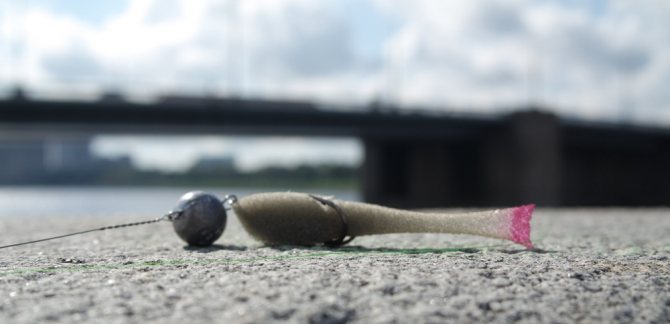
Cords...
As for the cords, it is here that in the rather heavy incarnation of jig fishing there is no point in being fashionable with their thin diameters. The Neva is replete with hooks, and after a couple of hours of evening fishing with a thin line, leaving a package of silicone baits in it is a trifle. And along with them, Cheburashkas and hooks will remain there. You do the math later, but there is no longer a decent amount. And everything would be fine, but often there are no pike perch either.
I tried different lines, from 0.12 to 0.4, and came to the conclusion that jigging on the Neva is best with lines of 0.2-0.25 mm - and they fly well (with such loads they would not fly well) and do not float in the water too much strong enough. The strength of the cord and leash is also important because sometimes you have to lift quite weighty pike-perch to the height of the embankments, and, as a rule, only the most “hardened” pike-perch fishermen have lifts - I don’t.
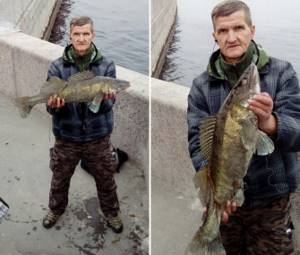
Some of my acquaintances, jig fishermen on the Neva, are very worried that with a thicker cord the tackle will not lose sensitivity. At the same time, they themselves use weights of a decent amount for 25 grams, which by definition “knock” with absolutely any cord. I understand the sensitivity of gear for difficult conditions in such a way that it is enough for me to feel only the first contact of the load with the bottom, so as not to further lift it, the load, too high. If the bait is nibbled by a medium-sized pike or small pike-perch, then I’m not interested in it and still let them go back, even if I brought it foolishly, and I can feel the bite of a large fish with a cord of any diameter.
Cords obviously include the use of all kinds of leashes. Moreover, it is more often used from ordinary fishing line. Metal ones are used much less often and for a long time I did not understand why. It turns out everything is simple! Pike, a great specialist in biting fishing lines and cords, is found in the Neva much less often than pike perch, which is not capable of such cunning, and accordingly there is no big point in coarsening the equipment. Perch competes with pike perch much more often than pike. Well, if a pike suddenly comes down, then it wasn’t a pike - we say so!
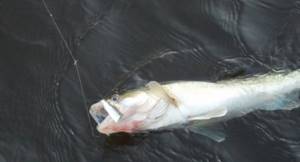
There is only one point in using fishing line leashes: fishing line resists bottom nonsense like shell rock, sharp stones or some sunken pieces of iron better than cord. Although the question here is what will come first: separation due to a blind hook or the cord itself will fray. In my personal practice, the cord has never frayed even once, but I tear the equipment out of the hook literally every fishing trip, but for peace of mind I still use fishing line and no less than 0.3 mm, i.e. The breaking load is equal to the cord or slightly less. But I’m not worried about the stealth of leashes at all – that’s nonsense. Each of us has more than once observed how much garbage floats in the water without our cords and fishing lines. And the fish is not afraid of any of this - all this is familiar to it. I don’t understand why he should suddenly be afraid of my cord or leash.
Types and colors of baits...
It is clear that we are talking about silicone twisters, vibrating tails and other simulators of worms, crustaceans, as well as all kinds of foam fish. What exactly it will be is not at all important and simply because literally any jig bait is caught in the Neva.
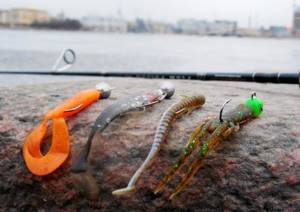
Of course, the size of the bait is dictated by the expected trophy and the weight of the load. And since I’m targeting a solid pike perch, and not a perch, I don’t skimp on small things - I use baits, usually 4-inch-long twisters. At the same time, among the local regulars there are those who like to fish, and very successfully, even with 6-inch baits.
With the colors of the baits, everything is simple: whatever color I like is the one I take. Lately I’ve really taken a liking to “fish a la naturel”, i.e. black back and white belly - well, it’s just like bleak. And I also like, for example, blue and white colors with sparkles. I liked something acidic only once, fished until I tore it all off, and then somehow didn’t pay any attention.
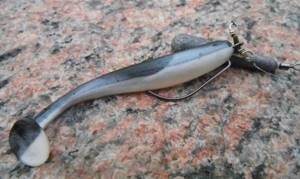
Why do I have this approach to choosing colors? Yes, everything is simple: you can know and understand where the fish are at a given period of time, but it is impossible to create a system of their preferences for the color of bait - everywhere there are very different environmental conditions, which, moreover, themselves change from time to time. Therefore, in order not to waste time and money on guessing color solutions, I prefer to simply fish with what I have, literally “freezing” the selected fishing area, wiring by wiring. And if there is a predator there, then sooner or later he will definitely attack my bait.
